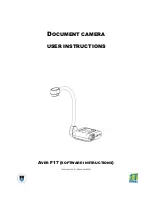
Compact Scientific Digital Cameras
Chapter 3: Setup & Installation
Rev A, June 3, 2020
Page 17
3.7.
Auxiliary Connector
The auxiliary connector on the camera allows the user to access optional camera control and internal status signals.
3.7.1. Pin Descriptions
Figure 7
Illustration of the Auxiliary Connector on the
Rear of the Camera
3.7.2. Signal Descriptions
•
Pins 1, 2, 3, 10, 11:
Ground. This is the electrical ground for
the camera TTL signals.
•
Pin 4, STROBE_OUT (Output):
STROBE_OUT is an LVTTL output that is high during the actual sensor
exposure time when in continuous, overlapped exposure mode. STROBE_OUT is typically used to
synchronize an external flash lamp or other device with the camera.
•
Pin 4 EEP Alternate Function (Output
– CC215MU Only):
EEP - Equal-Exposure Pulse is available when
Equal-Exposure Pulse is selected in the ThorCam Settings Dialog or by other means. This signal is active
from the time when rolling reset is complete to the time when rolling readout commences. The Equal
Exposure Pulse is typically used to synchronize an external flash lamp or other device with the camera in
order to produce uniform exposures across the entire ROI. See Section 4.3.
•
Pin 5 TRIGGER_IN (Input):
TRIGGER_IN is an LVTTL input used to trigger exposures on the camera.
Transitions can occur from the HIGH to LOW states or LOW to HIGH, as selected using the ThorCam
interface. Default is Low to High. Minimum Trigger Pulse-width is 100 µs.
•
Pin 6, LVAL_OUT (Output):
LVAL_OUT
refers to “Line Valid Output.” It is an active-HIGH LVTTL signal
and is asserted during the valid pixel period on each line. It returns low during the inter-line period between
each line and during the inter-frame period between each frame.
•
Pin 7, OPTO I/O_OUT (Output):
The OPTO I/O_OUT signal is an optically isolated output signal. The user
must provide a pull-up resistor to an external voltage source of 2.5 V to 20 V. The pull-up resistor must limit
the current into this pin to <40 mA. The default signal present on Pin 7 is the STROBE_OUT signal, which
is effectively the Trigger Out signal as well. Note: The value of the user supplied pull-up resistor affects the
rise and fall time of this output.
•
Pin 8, OPTO I/O_RTN:
This is the return connection for the OPTO I/O_OUT output and the OPTO I/O_IN
input connections. This must be connected to the pull-up source for OPTO I/O_OUT or the driving source
for the OPTO I/O_IN signals.
Pin Descriptions
Pin #
Signal
1
Ground
2
Ground
3
Ground
4
LVTTL STROBE_OUT / EEP
5
LVTTL TRIGGER_IN
6
LVTTL LVAL_OUT
7
OPTO I/O_OUT STROBE
8
OPTO I/O_ RTN
9
OPTO I/O_IN
10
Ground
11
Ground
12
LVTTL FVAL_OUT
















































